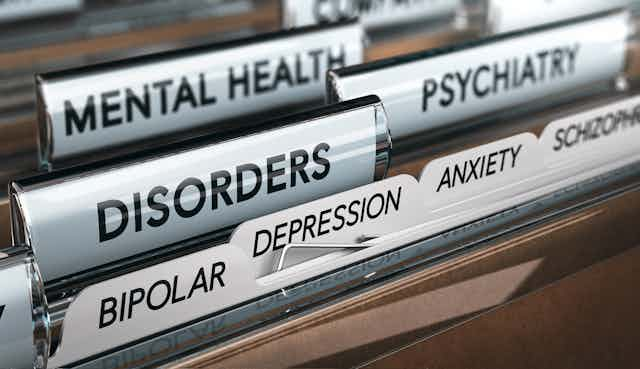The number of people diagnosed with a mental health condition is increasing, globally. Diagnostic labels can act as passports to accessing public services and help create communities of individuals with the same label. But are these reasons enough to justify their continued use? Getting a diagnostic label is no guarantee of getting the right treatment and it is often associated with worry and stigma.
Some say that they’re necessary for research. Scientists hope that diagnostic labels for mental health conditions will neatly correspond with specific physiological markers. But a definitive blood test or MRI-based brain marker for conditions such as autism and depression continues to elude scientists.
Also, mental health conditions have highly variable symptoms. They are not clear cut like other medical conditions, such as bone fractures or tooth decay. And a broken bone today is the same as a broken bone in ancient Greece. However, diagnostic criteria for mental health conditions keep shifting, even over relatively short periods of time.
A recent report showed that over a fifth of people diagnosed of autism spectrum disorder (ASD), using diagnostic criteria from 2004, would not receive the same diagnosis based on the latest criteria, published in 2013. To add to the confusion, many people can have more than one diagnostic label – a phenomenon known as “comorbidity”.
The inherent lack of precision in defining the diagnostic label, the changing criteria with time and the rarity of pure examples of a specific mental health condition vastly reduce the usefulness of diagnostic labels in guiding research. Indeed, the National Institute of Health in the US recognised this problem some years ago and called for a new approach to researching mental health conditions. This approach, called the research domain criteria (RDoC), focuses on studying traits across the general population and their underlying biology, rather than on specific diagnostic labels.
From a treatment point of view, knowing the diagnostic label alone is hardly ever enough information to decide the best course of action. For example, a person with a diagnosis of ASD might have significant sensory issues, while another might struggle more with language. These two people will benefit from very different interventions. It’s not an overstatement to say there is no one-size-fits-all intervention for any mental health diagnostic label. So the usefulness of a diagnostic label for choosing the right treatment is limited.
The approach of focusing on the person rather than the label is known as precision psychiatry. This customised approach seeks to target the specific symptoms experienced by the individual in light of his or her genetic, social and cultural background. Hippocrates echoed a similar sentiment over two millennia ago when he stated:
It’s far more important to know what person the disease has than what disease the person has.
Public health
A significant part of my work is in developing countries where there is a shortage of specialists who can provide a diagnosis. For most mental health conditions, early intervention is critical – it is associated with the best outcomes. Delays in getting a diagnostic label lead to delays in getting treatment in these countries and so can result in a reduced chance to benefit from the intervention.
If getting support for mental health issues did not have to rely heavily on the diagnostic label, then access to treatment could be accelerated by involving non-specialists from the community and families. Health workers with little or no clinical training, such as those involved in vaccination drives, could be trained to identify people at risk of having or developing mental health conditions, as is being done in our current project in India.
Families of people identified of being at risk of a mental health condition can then be trained to apply simple behavioural interventions that have been shown to be effective. This approach of identifying at-risk people early and using simple non-specialist behavioural interventions is associated with significantly better mental health outcomes in children and adolescents. Crucially, this approach does not rely on getting a formal diagnostic label.
At a time when rates of diagnosis for mental health conditions keep spiralling upward, it is worth imagining a world without diagnostic labels: one where an individual is assessed on his or her functional needs and receives care based on the specific needs rather than a somewhat arbitrary label. A world without stigma due to these labels. And a world where scientists focus their search on understanding the biology of behaviour across the entire population, rather than create arbitrary groups of people defined by their labels as “cases” and “controls”.

